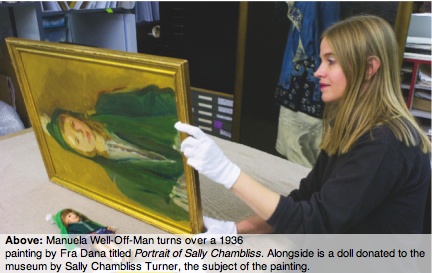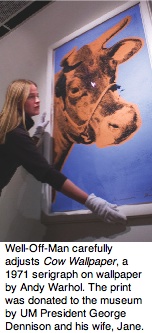The State's Hidden Treasure:
UM Seeks Home for Permanent CollectionBy Ginny Merriam
 In a basement in the heart of The University of Montana campus, Montana artist Fra Dana glows across the decades.
In a basement in the heart of The University of Montana campus, Montana artist Fra Dana glows across the decades.
Her auburn hair, drawn up on the back of her neck, reflects the leaves in the Montana landscape outside her window. Her blue cape flows around her as she absorbs the outside world from the newspaper in her hands.
Dana’s self-portrait oil painting On the Window Seat came to the University’s permanent art collection after she died in 1948. It’s one of the most famous works at UM, but few people see it because the collection has no home. Ten thousand works of art are spread among seven locations on and off campus, and some of them are on view on campus and around the state. But only one-half of 1 percent of them can be exhibited at any given time.
The story astounds nearly all who hear it. Visionary collectors, artists, faculty members, and administrators began the collection 114 years ago, just a year after the University itself was founded. Today’s 10,000 pieces are valued at more than $17 million. They include Dana’s work and the work of her teachers—major painters such as Alfred Maurer—and much more. A Rembrandt etching from 1632 is stored alongside the contemporary works of pop artist Andy Warhol, Montana artist Henry Meloy’s modern forms, a Japanese print circa 1796, Rudy Autio’s bold ceramics, and Edgar Paxson’s 1904 oil painting Sacajawea. British painter John Brown, called the “Boot Black Raphael,” speaks to viewers from 1900 with his painting of a pink-cheeked boy, and a Spanish altar panel survives the fifteenth century with its circa-1495 image of St. Gregory.
“These are treasures,” says Barbara Koostra, director of the Montana Museum of Art & Culture, which houses and manages the collection and looks toward its future. “When I show examples of pieces in this collection, people’s jaws drop.”
“People are stunned, universally stunned, when they see it,” says Jim Foley, University executive vice president.
Museum curator and art historian Manuela Well-Off-Man knows the collection intimately, curating exhibits from it that are shown in the campus galleries and on tour. She loves to tell the stories.

Take Dana’s self-portrait and her cascading blue cape. Then look at Alfred Maurer’s nearly life-size oil painting Gabrielle from 1900. Dana, though married to a Montana rancher, traveled and studied art in Europe and donated the works of her teachers along with her own paintings. The model Gabrielle, posing for Maurer around 1900, wears the same blue cape.
“So Fra Dana not only purchased Alfred Maurer’s painting, she must have also talked him out of the cape,” Well-Off-Man says.
Well-Off-Man can go to a basement shelf and carefully unroll white preservation foam to show a 1930s child’s doll. Its perfect pretty face with porcelain complexion and red bow of lips are framed by a green hood. In the collection is also a 1936 Fra Dana painting, Portrait of Sally Chambliss. The girl Sally wears a green hood.
Dana donated the painting. Years later, Sally Chambliss Turner, who grew up in Great Falls and now lives in Florida, came back to tell the story of visiting Dana in the Blackstone Apartments in Great Falls as a girl with her parents—and her doll—and having her portrait painted. She donated the doll.
“That’s what makes a collection valuable,” Well-Off-Man says. “It’s not just how famous the painter was. It’s also the stories you have. And the value of the collection is in the relationships among them, too.”
Well-Off-Man is one of hundreds of people in UM’s history who have nurtured the collection through its century.
“Ever since 1894, it’s been such a legacy of giving,” Koostra says. “There were some very caring professionals and volunteers.”
|
|
|
|
|
The Montana Museum of Art & Culture's Permanent Collection includes groups of treasures that have been donated throughout the years. These are just a few.
|
||
|
|
|
Today, under the umbrella of the UM President’s Office, the museum and the collection have stepped into a new phase. Koostra, the UM Foundation, and the museum’s board of advisors are raising $13.5 million for an endowment and a museum building, where the Permanent Collection will be the centerpiece.
“The Permanent Collection belongs to all Montanans, in perpetuity,” Koostra says. “It’s my dearest hope that it’s the enduring quality of the collection that propels people to help.”
Conceptual drawings and a program analysis developed by John Hilberry Museum Consulting of New York and A & E Architects of Missoula and Billings show a bright, state-of-the-art, 33,000-square-foot building set on the north edge of campus near the Van Buren Street footbridge and the Fitness and Recreation Center, where town meets gown. It will serve as a campus gateway and have space for exhibitions and educational programs and nearly 10,000 square feet of climate-controlled storage.
The building will glow with light from the inside, Koostra says.
“Anybody can move into a house,” she says. “This will be a home.”
Montana, for its third state museum, simply deserves the best, says Helen Ingersoll Cappadocia, a native of the state and an art donor who supports the museum and the idea of a building.
“I think the time has come for us to have one of the best museums in the country,” Cappadocia says. “Not because we have the population, not because we have the wealth, but because we have the vision.”

The Permanent Collection’s story has always been one of abundant vision and limited resources, Koostra says. It was founded and grown by alumni and business people who believed in the University as a center for art. Many graduated, traveled the world during their careers, collected art, and then donated it.
In 1912, the effort took shape as the Northwest History Museum. It had its first exhibit in Main Hall and then later displayed art in the Journalism Building and Turner Hall. Among the first donors were the Gibsons—A.J. Gibson being the architect of Main Hall, the Daly Mansion, and the Missoula County Courthouse.
In the 1930s, the first plan for a museum building showed a complex with a central gallery and four wings housing art, history, anthropology, and science. It went as far as architectural drawings, but funding never materialized.
In 1937, the Women’s Club Art Building (known in modern times as International Studies) was built with a donation from the Woman’s Club and the help of the Works Progress Administration. From 1937 to 1955, it was touted as “housing the first art museum in the Inland Northwest.” Why its purpose changed is unclear.
The collection went on, shepherded notably by faculty, especially of the Department of Art. Professor Jim Dew met Fra Dana and talked with her about her collection. Professors Rudy Autio and Don Bunse helped, along with Maxine Blackmer.
In 1977, the collection was the victim of a robbery. The robbers took small objects. When the police worked to put a report together, the guardians of the collection realized they had to work from mental lists because the art was not fully catalogued.
“In art as in life, sometimes something really bad has to happen before we realize a problem,” Koostra says. “It’s such a different place now. People on this campus really cared about this collection. But there just wasn’t the resource base.”
Under the direction of Dean Kathryn Martin beginning in the late 1970s, curator Dennis Kern began a rigorous cataloging and evaluation of the works that moved their care into the professional realm.
In 2001, the collection moved under the wing of the President’s Office. Under the direction of Maggie Mudd, the Montana Museum of Art & Culture was designated by the state of Montana as one of three state museums, joining the Montana Historical Society Museum in Helena and the Museum of the Rockies in Bozeman. President George Dennison, a collector who has donated art to the museum, moved it onto the priority list.
|
|
|
|
|
To learn how you can help build a museum for UM’s Permanent Collection, contact: Barbara Koostra, director of the Montana Museum of Art & Culture, The University of Montana, Missoula, Montana, 59812 406-243-2019; barbara.koostra@umontana.edu or Ric Thomas, vice president for development, UM Foundation, P.O. Box 7159, Missoula, Montana, 59807; 406-243-4965; ric.thomas@mso.umt.edu |
||
|
|
|
“I really think he believed in order to get it out of the basements, he had to talk about it more,” Foley says. “He saw it and recognized its importance.”
Koostra, a musician who grew up in Missoula, performed around the country, and earned her master’s degree in business administration at UM, became the museum’s director in January 2005. When she interviewed for the job, she knew it was the perfect fit. The museum was ready to leap into a long-range plan, a marketing plan, a revised collections management policy, a reconstituted advisory board, new partnerships, and national traveling exhibitions, along with plans for a building.
Today, the museum has eight changing exhibitions a year in its Paxson and Meloy galleries. Help from the Chutney Foundation and Grizzly Riders International has brought restoration funding. Four exhibitions are currently traveling, and Well-Off-Man is putting together a traveling show of Josephine Hale—a Montana painter who also was the first female Red Cross volunteer—set to tour in 2010. An exhibit of Rembrandt’s etchings, “Sordid and Sacred: The Beggars in Rembrandt’s Etchings,” will be on view on campus in March and April 2008.
The goal for construction of the new museum building is a groundbreaking in 2010 or 2011 at the northeast corner of the campus.
“One of my favorite things about this job is building relationships,” Koostra says. “There are a lot of people who want to give back. They’re looking at art in a long-term way—a window into another time, a window into another culture, another experience in being alive, a window into the way an artist thinks. Because of how international our collection is, we have this to offer, in spades.”
![]() Ginny Merriam ’86 is a freelance journalist who lives in
Missoula. An award-winning reporter for the Missoulian for
twenty years, she currently is the communications director for the
City of Missoula.
Ginny Merriam ’86 is a freelance journalist who lives in
Missoula. An award-winning reporter for the Missoulian for
twenty years, she currently is the communications director for the
City of Missoula.